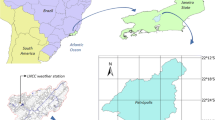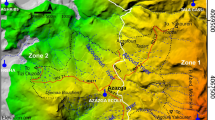Abstract
This paper is a contribution to an important aspect of the systematic and quantitative assessment of landslide hazard and risk. The focus is on site-specific and detailed assessment for rainfall-triggered landslides and, in particular, on the estimation and interpretation of the temporal probability of landsliding. Historical rainfall data over a 109-year period were analysed with particular reference to a site along the Unanderra and Moss Vale Railway Line in the State of New South Wales, Australia. It is shown that the recurrence interval of landsliding and hence annual probability of occurrence is subject to significant uncertainty and that it cannot be regarded as a constant. Accordingly landslide hazard varies spatially as well as being a function of time. For the example case study considered in this paper the annual probability of landslide occurrence was estimated to be in the range 0.026–0.172. However, the mean annual probability of landslide reactivation was estimated to be in the range 0.037–0.078. Utilisation of methods for probability assessment proposed in this paper will contribute to more realistic assessment of hazard and risk and, therefore, to more efficient risk management.








Similar content being viewed by others
References
AGS (2000) Landslide Risk Management Concepts and Guidelines. Australian Geomechanics Society Sub-Committee on Landslide Risk Management, Australian Geomechanics, Vol. 35, No.1, March, pp 44–92
Bowman HN (1972) The Geology and Natural Slope Stability of the City of Greater. Master of Science Thesis, University of Sydney
Cruden DM, Varnes DJ (1996) Landslide Types and Processes. In: Turner and Schuster (eds) Landslides, Investigation and Mitigation, Chapter 3, Special Report 247. Transportation Research Board, National Research Council. National Academy Press, Washington, DC
Fiorillo F, Guadagno FM (2000) Analysis of Rainfall Patterns Triggering Reactivations of a Large Landslide in Pleistocene Clay in Molise (Italy). In: Bromhead E, Dixon N, Ibsen ML (eds) Landslides in Research, Theory and Practice. Proceedings of the 8th International Symposium on Landslides, Vol. 2, Cardiff, 26–30 June 2000. Thomas Telford, London, pp 553–558
Flentje PN (1998) Computer Based Landslide Hazard and Risk Assessment (Northern Illawarra Region of New South Wales, Australia). Ph.D. Thesis, The University of Wollongong, New South Wales, Australia, unpublished
Flentje PN, Chowdhury RN (2000) Slope Instability, Hazard and Risk Associated with a Rainstorm Event—A Case Study. In: Bromhead E, Dixon N, Ibsen ML (eds) Landslides in Research, Theory and Practice. Proceedings of the 8th International Symposium on Landslides, Vol. 2, Cardiff, 26–30 June 2000. Thomas Telford, London, pp 560–566
Flentje P, Chowdhury RN (2001) Aspects of Risk Management for Rainfall—Triggered Landsliding. Proceedings of the Engineering and Development in Hazardous Terrain Symposium, New Zealand Geotechnical Society Inc. University of Canterbury, Christchurch, New Zealand. The Institution of Professional Engineers New Zealand, August 24–25, pp 143–150
Flentje P, Chowdhury RN (2002) Frequency of Landsliding as Part of Risk Assessment. Australian Geomechanics News, Vol. 37 Number 2, May. Australian Geomechanics Society, Institution of Engineers, Australia, pp 157–167
Glade T (2000) Modelling Landslide Triggering Rainfall Thresholds at a Range of Complexities. In: Bromhead E, Dixon N, Ibsen ML (eds) Landslides in Research, Theory and Practice. Proceedings of the 8th International Symposium on Landslides, Vol. 2, Cardiff, 26–30 June 2000. Thomas Telford, London, pp 633–640
Guadegno FM, Zampelli P (2000) Triggering Mechanisms of the Landslides that Inundated Sarno, Quindici, Siano, and Bracigliano (S. Italy) on May 5–6, 1998. In: Bromhead E, Dixon N, Ibsen ML (eds) Landslides in Research, Theory and Practice. Proceedings of the 8th International Symposium on Landslides, Vol. 2, Cardiff, 26–30 June 2000. Thomas Telford, London, pp 671–676
Hall JW, Corcoran CM (2000) Identification of Critical Rainfall Duration Periods for Individual Natural and Excavated Slopes. GeoEng 2000, An International Conference on Geotechnical and Geological Engineering, 19–24 November 2000, Melbourne, Australia, Vol. 2, PAPERS\SNES.pdf. CD-Rom
Hazelton PA (1992) Soil Landscapes of the Kiama 1:100,000 Sheet. Department of Conservation and Land Management (incorporating the Soil Conservation Service of NSW), Sydney
Hazelton PA, Tille PJ (1990) Soil Landscapes of the Wollongong-Port Hacking 1:100,000 Sheet. Soil Conservation Service of NSW, Sydney
Ko Ko C (2001) Landslide Hazard and Risk Assessment Along a Railway Line, Ph.D. thesis, University of Wollongong, New South Wales, Australia (Unpublished)
Ko Ko C, Flentje P, Chowdhury R (2003) Quantitative Hazard and Risk Assessment: a Case Study. J Eng Geol Hydrogeol 36:261–271
Ko Ko C, Flentje P, Chowdhury R (2004) Landsldies Qualitative Hazard and Risk Assessment Method and its Reliability. Bulletin International Association of Engineering Geology and the Environment 63(2):149–165
Okada K, Sugiyama T, Muraishi H, Fujimura H (1999) Zonation of Areas Susceptible to Rain-induced Embankment Failure. In: Yagi N, Yamagi T, Jiang J-C (eds) Slope Stability Engineering. Proceedings of the International Symposium on Slope Stability Engineering: Geotechnical and GeoEnvironmental Aspects, Vol. 1, 8–11 November 1999. Matsuyama, Shikoku, Japan. Balkema, Rotterdam, pp 453–458
Pang PLR, Pun W-K, Yu Y-F (2000) Estimation of Failure Frequency of Soil Cut Slopes Using Rainfall and Slope Information. GeoEng 2000, An International Conference on Geotechnical and Geological Engineering, 19–24 November 2000, Melbourne Australia. Vol. 2, PAPERS\SNES.pdf. CD-Rom
Yokota S, Iwamatsu A, Imura R, Matsuyuki K, Ohkawa T (2000) A New Warning Index for Debris Flows Based on Rainfall and Groundwater Depth. GeoEng 2000, An International Conference on Geotechnical and Geological Engineering, 19–24 November 2000, Melbourne Australia. Vol. 2, PAPERS\SNES\Snes0481.pdf. CD-Rom
Author information
Authors and Affiliations
Corresponding author
Rights and permissions
About this article
Cite this article
Ko Ko, C., Flentje, P. & Chowdhury, R. Interpretation of probability of landsliding triggered by rainfall. Landslides 1, 263–275 (2004). https://doi.org/10.1007/s10346-004-0031-3
Received:
Accepted:
Published:
Issue Date:
DOI: https://doi.org/10.1007/s10346-004-0031-3




